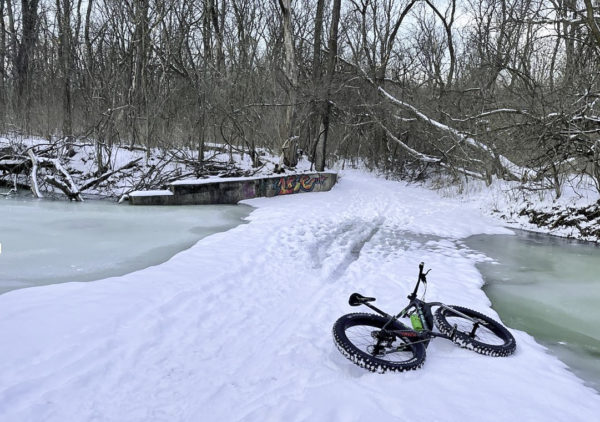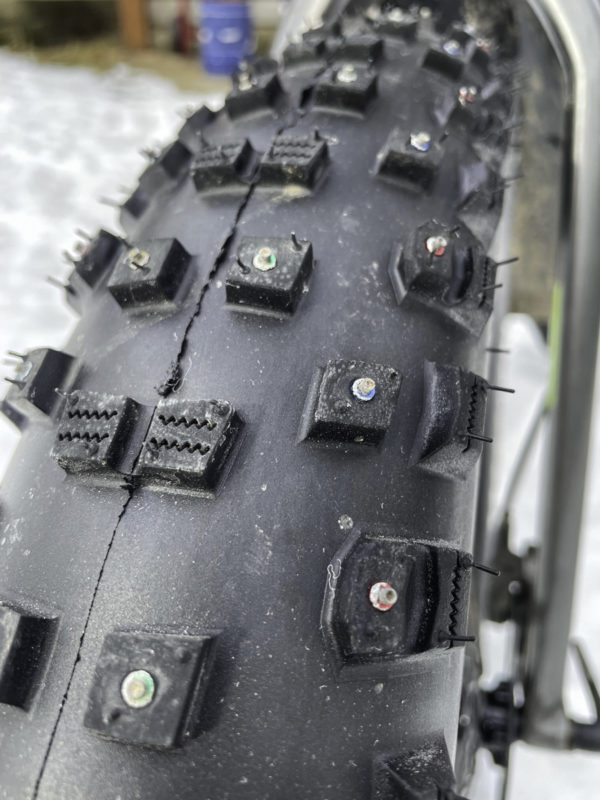Fatbike tires in general already offer outstanding traction and ride quality in a wide variety of conditions. For sandy beach riding or snow of any depth, fat tires are a necessity. Why would any fat bike rider need studs? Ice. As much as most of us love snow, ice is always some factor in winter season cycling. Whether it is on your trails as a result of the freeze/thaw cycle, rainy or wet snow falling, or packed ice on a plowed roadway, ice has one of the lowest known coefficients of friction and is more likely to spit you off your bicycle than most other winter factors. How do you cope with this? Stud your tires!
Our amigos at the Trek Store of Anchorage sent us these colorful and wonderful Billy Flamingo Stud Nuggets. How about that for a name?! These particular stud nuggets are concave hollow tip fat bike tire studs. They come packed in quantities of 101 or 261, to give you more value for your money and maybe to make up for the one that always seems to roll under your workbench with the spiders. Stud Nuggets are made with a lightweight aluminum body and a carbide center element which provides extra traction.
The brilliant red, yellow, blue, and green anodized colors really set these apart from your run-of-the-mill studs. And speaking of mills, I noticed that these studs stick out from the tire noticeably farther than my old Brand X studs. It appears that the concave tip studs are slightly longer, 6.3mm, vs my old flat tip studs which measure 5.7mm. While 0.6mm does not sound like much, it is significant in terms of ice penetration and well, pavement noise. 101 studs weighed 62 grams, 262 studs weighed 151 grams. Considering that most fat bike tires weigh around 1500 grams, this additional weight seems pretty negligible.
Installation was fairly straightforward, and using a screwdriver style stud insertion tool I proceeded to dip each stud in rubbing alcohol as a lubricant before seating it into the factory tire stud pockets. Tire pressure was set at 20 psi so that the tire knobs do not flex around too much while inserting the studs.
I was setting up a new pair of Bontrager Gnarwhal 27.5 x 3.8” tires, which each have 216 stud pockets. It has been a couple of years since I have done this, and it took me a while to get the hang of pushing the stud into the pocket at about a 30-degree angle to get it started, and then tipping the tool straight up and down to make sure each stud was fully seated at the bottom. Since I was doing this job this winter, near Christmas, I was able to watch both Die Hard 1 and most of Die Hard 2 in the time it took me to get the deed done. When I was all done, I have to admit the colored studs did look pretty cool. They are not very big, so I doubt anyone will notice them from more than ten feet away, but riders who decide to do this themselves will be satisfied.
This might be a good time to mention the safety aspect of dealing with these studs. These concave point studs are very sharp, which helps them do their job on ice, but can also do a job on your arms and legs. By the time I was halfway done with the first tire, it was easy to tell that handling it with some caution would be a very good idea. Long pants and maybe even long sleeves are in order for this process. The same caution goes for your home and your car: these studs will scratch almost anything. Your flesh, your walls, floors, and the interior of your car are all subject to possible new unplanned stripes if not watched carefully.
Most stud manufacturers recommend some pavement riding right after installation, in order to properly seat the studs so they do not pull out during hard climbing or heavy braking. I rode these about 5 miles on my local neighborhood streets as a break-in period. About half of the color on the center rows of studs was missing, so be warned that some of the cosmetic effects of the anodizing will be lost over time. The concave carbide center points all looked perfect though and did not show any wear.
Going straight to my local State Park, testing commenced with the first ½ mile of glazed-over paved path that joins the parking lot to the trails. Rain and 25-degree temps had laid down a sheet of glare ice on top of the asphalt These studs dug in and did not slip even the tiniest bit. I even slalomed a bit on this ice without any problem. The local trails had long patches of ice which were underneath 2” to 3” of recent snow. Hikers and runners had churned this up quite a bit without actually packing it down yet, so there were many opportunities on climbs and descents to run into ice. This again is when studded tires really shine, as you cannot see the ice that lies under fresh snow or ice that is uncovered by traffic from other users. In sections that were better groomed or packed, the studs made no extra noise and did not change the traction available, which is more a function of tire tread design and knob depth. Later test rides offered similar results, and I noticed that it was easier to handle the icy roots that appear on some of our climbs. The front tire never slipped sideways, and the rear tire had traction when I knew my old tires would have spun.

Altogether I have put about 70 snow miles on this setup, and I am very satisfied with the results. Other tires and studs I have used in the past include homemade sheet metal screws which were cheap and highly effective but very heavy and slow, studded Dillinger 4’s, and studded Bontrager Gnarwhal 4.5’s. The Dillinger and Gnarwhals both had conventional flat studs, which worked fine for their purpose and the studs proved to be durable. These longer concave tip Stud Nuggets take ice traction to the next level, at the cost of some additional noise on the pavement. For the majority of normal snow, ice, and groomed trail use, these studs offer better performance. The anodized colors look great on the shelf and are a fun visual, but long term probably won’t maintain their style points. For commuters and people who put in a lot of pavement miles, or who care about being able to carry on a conversation while riding, I think conventional flat-tipped studs would be fine. Anyone who is looking for a way to justify the cost of these studs can compare the cost of a broken collarbone or wrist, plus time off the bike, to see the additional safety benefit of a few dollars spent on studs for winter riding.
For more information about Billy Flamingo’s Stud Nuggets drop into the Trek Store in Anchorage or visit – https://www.trekstorealaska.com/product/billy-flamingos-stud-nuggets-bike-tire-studs






Pretty cool if you want to add some bling to your bike. Studs are pricey but not when compared to a hip replacement………a “T” handle stud inserter makes the job much easier.